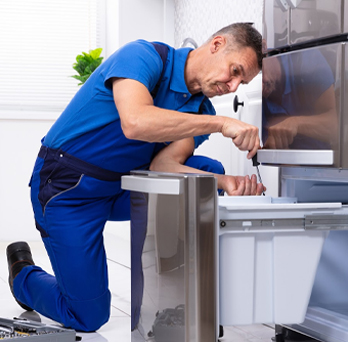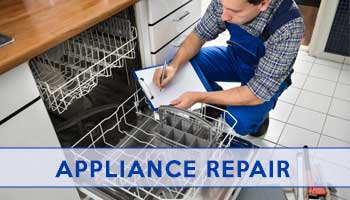What Appliance Pros Recommend for Home Efficiency—Use Dependable Refrigeration & Appliance Repair Service SubZero Repair
What Appliance Pros Recommend for Home Efficiency—Use Dependable Refrigeration & Appliance Repair Service SubZero Repair
Blog Article
The Ultimate Guide to DIY Home Appliance Fixing Strategies
When appliances damage down, it's simple to really feel overloaded. Dependable Refrigeration Appliance SubZero repair near me. However with the best expertise and tools, you can deal with usual problems on your own. From refrigerators to dishwashers, recognizing how to fix and repair these gadgets can conserve you time and money. Are you all set to uncover important methods that will encourage you to handle repair work confidently? Allow's discover the vital locations where DIY skills can make a significant difference.
Recognizing Usual Appliance Problems
When you rely upon your home appliances, it can be annoying when they instantly quit working or break down. Understanding common home appliance problems can assist you repair concerns properly. As an example, if your fridge isn't cooling down, check the temperature setups or check the door seal for gaps. A malfunctioning washing equipment may be because of a clogged up drainpipe filter or a damaged belt.
If your oven isn't home heating, faulty aspects or thermostat issues might be responsible. Dishwashing machines frequently experience problems with drain, so see to it the filter is clean and the drainpipe tube isn't kinked.
Likewise, listen for unusual sounds; they commonly show mechanical problems. By identifying these indicators, you can save time and potentially avoid pricey repair services. A little expertise goes a long means in maintaining your appliances, so stay notified to keep every little thing running smoothly.
Necessary Devices for DIY Repair Works
Before diving into do it yourself appliance repair services, it is very important to gather the right tools to guarantee the process goes efficiently. Beginning with a great set of screwdrivers, consisting of both flathead and Phillips, as they're crucial for opening up most devices. You'll also desire a set of pliers for grasping and twisting cables or little parts.
Don't forget a multimeter; it assists you examination electrical elements and diagnose problems properly. An outlet collection is handy for loosening up or tightening bolts, while an utility blade can be beneficial for opening or reducing cables packaging.
Ultimately, think about having a flashlight on hand to brighten dark spaces inside your appliances. With these vital tools, you'll be well-appointed to tackle various repair services, saving both money and time. So, gather your gear and prepare to roll up your sleeves!
Safety First: Safety Measures to Take
Prior to you start any device repair, it's vital to prioritize safety. Make particular you wear personal protective tools, separate the source of power, and maintain your job location organized. These simple precautions can help prevent mishaps and assure a smoother repair service procedure.

Personal Protective Tools
Safety equipment is a vital part of any kind of do it yourself appliance fixing task. You need to constantly put on safety and security goggles to protect your eyes from dirt and particles. A tough pair of handwear covers will certainly shield your hands from sharp sides and harmful materials. Think about making use of a mask if you're handling chemicals or dust, ensuring you breathe securely while working. Steel-toed boots are likewise a wise option, particularly when raising hefty home appliances. Do not forget to put on long sleeves and trousers to shield your skin from prospective injuries. By prioritizing personal safety tools, you'll substantially reduce the risk of injuries and mishaps. Remember, being prepared with the best equipment keeps you safe and concentrated on finishing your repair effectively.
Source Of Power Disconnection
To assure a risk-free DIY appliance repair work, disconnecting the power resource is crucial. This straightforward action protects against electrical shocks and guarantees that you can concentrate on the repair service without worrying regarding unintentional activation. As soon as you're certain that the power is detached, you can with confidence proceed with your repair work, recognizing you have actually taken the essential safety measures to shield on your own.
Workspace Organization
A well-organized workplace can make all the distinction in your DIY device repair project. Begin by clearing your workspace of clutter to stop diversions and crashes. Outline all your tools and products, grouping similar things with each other for very easy access. Make use of a tool kit or coordinator to maintain small parts like washers and screws consisted of and labeled. Ensure you have actually got adequate lights; it'll help you see details plainly and reduce the danger of blunders. Don't fail to remember to keep safety and security equipment like gloves and safety glasses within reach. Finally, have a trash can useful to take care of waste quickly. A tidy space not just boosts effectiveness however additionally keeps you secure while you work with your appliance repair work.
Step-by-Step Overview for Refrigerator Repair Works
When your fridge begins acting up, it can be aggravating, but tackling the issue yourself can save you time and money. Examine for common concerns like temperature changes or uncommon noises. For a noisy refrigerator, check the follower and confirm it's not obstructed.
If there's water pooling within, inspect the door seals for damage or dirt, and tidy them if required. As soon as you have actually addressed the problem, connect the fridge browse around here back in and monitor it for a few hours.
Taking Care Of Cleaning Machine Problems
Simply like fridges, cleaning makers can provide their very own collection of difficulties, but lots of problems can be solved with a little bit of troubleshooting. If your maker will not start, check the power cord and confirm it's connected in.
If your clothing aren't getting clean, consider the water degree and cleaning agent type; making use of way too much cleaning agent can produce excess suds, influencing efficiency. For leaks, analyze the pipes for cracks or loosened links. Tightening these can commonly fix the problem. Normal maintenance, like cleaning the filter, can avoid numerous problems from occurring. Bear in mind, a little troubleshooting goes a lengthy way in keeping your washing device running smoothly.
Troubleshooting Stoves and stoves
How can you troubleshoot usual issues with your oven or oven? Beginning by examining the power supply. Make sure it's connected in and the circuit breaker is not tripped. If it's a gas stove, confirm the gas shutoff is open. Next off, examination the burners: if they don't fire up, clean the igniter and check for obstructions in the heater ports.
If your oven isn't heating, evaluate the temperature settings and verify the door seals tightly. A faulty burner can also be the offender; you may require to change it if it's damaged.
For unequal cooking, rotate your frying pans and consider using an oven thermometer to verify precise temperatures. If you hear unusual noises or odor gas, turn off the appliance quickly and consult a professional. By adhering to these actions, you can recognize and fix several typical oven and cooktop problems efficiently.
Fixing Dish Washers Made Easy
When your dishwashing machine starts breaking down, it can be discouraging, yet attending to common concerns isn't as tough as it seems. You'll discover detailed troubleshooting techniques that will aid you identify the problem, in addition to the necessary devices you'll need to tackle fixings yourself. Allow's make repairing your dish washer a breeze!
Typical Dishwashing Machine Issues
While dish washers are created to make your life less complicated, they can in some cases encounter common problems that leave you feeling discouraged. One frequent trouble is inadequate cleansing performance; this frequently happens because of clogged up spray arms or filthy filters. You might also observe water pooling at the bottom, which can show a malfunctioning drainpipe or a kinked hose pipe. It can be an easy problem with the latch system or door seal if your dishwasher's door will not latch. Furthermore, strange sounds can signal loose parts or damaged components. Lastly, if you smell something odd, it might be time to check for food debris or a malfunctioning motor. Addressing these concerns early can save you time and problem in the future (Emergency Sub-Zero Repair Dependable Refrigeration imp source & Appliance Repair Service).

Step-by-Step Troubleshooting
Prior to diving into fixings, it's crucial to recognize the particular concern your dishwashing machine is facing. If your dishwashing machine will not begin, inspect the power supply and door lock. By methodically addressing each potential problem, you can pinpoint the problem and take the needed actions to repair it, making your dish washer feature like true vine appliance repair new once again.
Necessary Repair Work Tools
When fixing your dish washer,Having the right tools at your disposal can make all the difference. Beginning with a screwdriver collection, as you'll frequently require both Phillips and flathead choices. A multimeter's essential for detecting electric concerns, while pliers can help you grip and control various components. Do not forget a container or towels for any type of water spills throughout fixings.
If you're taking on obstructions, a drainpipe snake or a wet/dry vacuum will be indispensable. You might also want a level to ensure your dish washer's effectively lined up. Safety and security gear like gloves and goggles will certainly shield you while you function. With these vital tools, you'll be fully equipped to tackle any type of dishwasher repair service difficulty that comes your means.
Frequently Asked Concerns
If a Home Appliance Is Worth Repairing?, just how Do I Identify.
To figure out if a device's worth fixing, consider its age, repair service costs, and existing value. If repair services go beyond half the substitute cost, you might intend to buy a new model instead.
Can I Discover Replacement Parts Locally for My Device?
Yes, you can typically find replacement parts locally for your home appliance. Check hardware shops, home appliance service center, or local classifieds. Do not forget to bring the version number to guarantee you obtain the right component!
When Repairing Appliances?, what Common Mistakes Should I Stay Clear Of.
When fixing devices, stay clear of rushing via diagnostics, overlooking security precautions, or making use of inaccurate tools. Do not skip reviewing handbooks or watching tutorials; they give necessary assistance. Hold your horses and detailed to ensure effective repair services and prevent more damage.
How much time Does a Normal DIY Home Appliance Repair Take?
A normal DIY home appliance repair normally takes one to 3 hours, depending upon the intricacy. You'll intend to collect your products and devices first, and comply with guidelines thoroughly to stay clear of unnecessary delays.
Exist Any Guarantees for Do It Yourself Device Repair Works?
When you deal with do it yourself home appliance fixings, warranties normally do not cover your work. Some suppliers might honor guarantees for parts you change. Constantly examine your appliance's warranty terms before starting any kind of repairs to prevent problems.
Prior to diving right into Do it yourself device fixings, it's important to gather the right tools to guarantee the process goes smoothly.Before you start any type of home appliance repair service, it's crucial to focus on safety.To guarantee a safe DIY appliance repair, disconnecting the power source is important.A well-organized work area can make all the difference in your DIY appliance repair work project. Always check your appliance's warranty terms before starting any repairs to stay clear of concerns.
Report this page